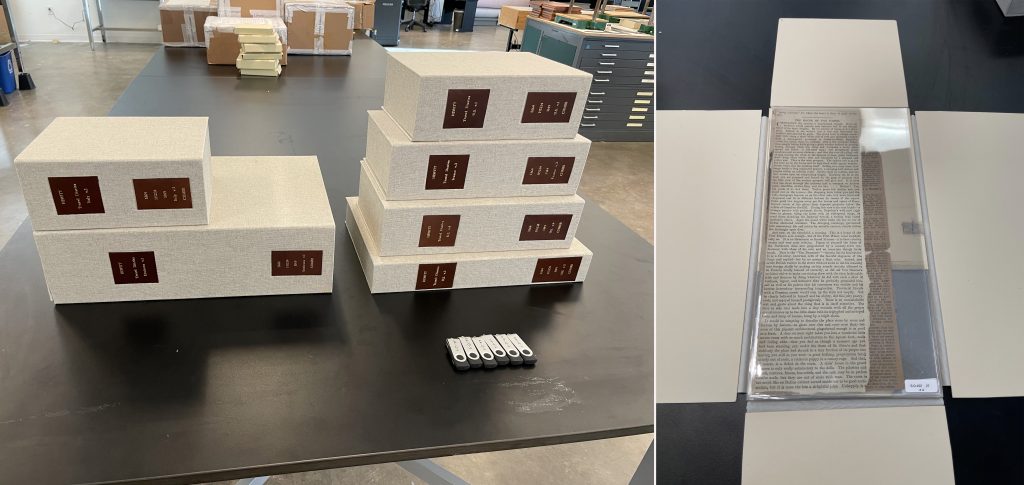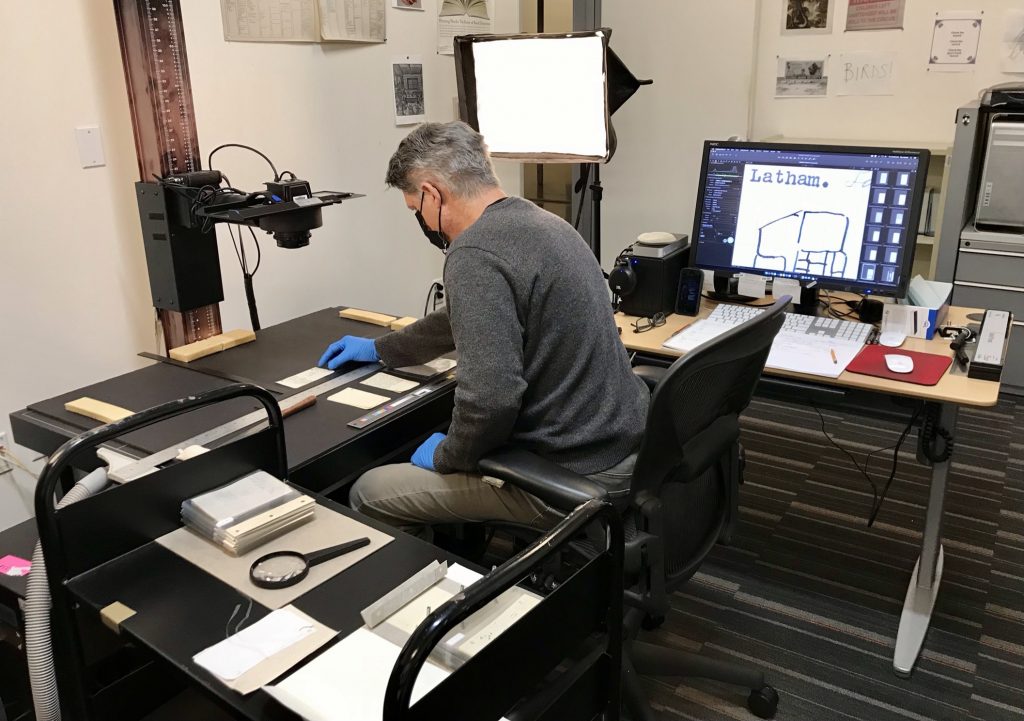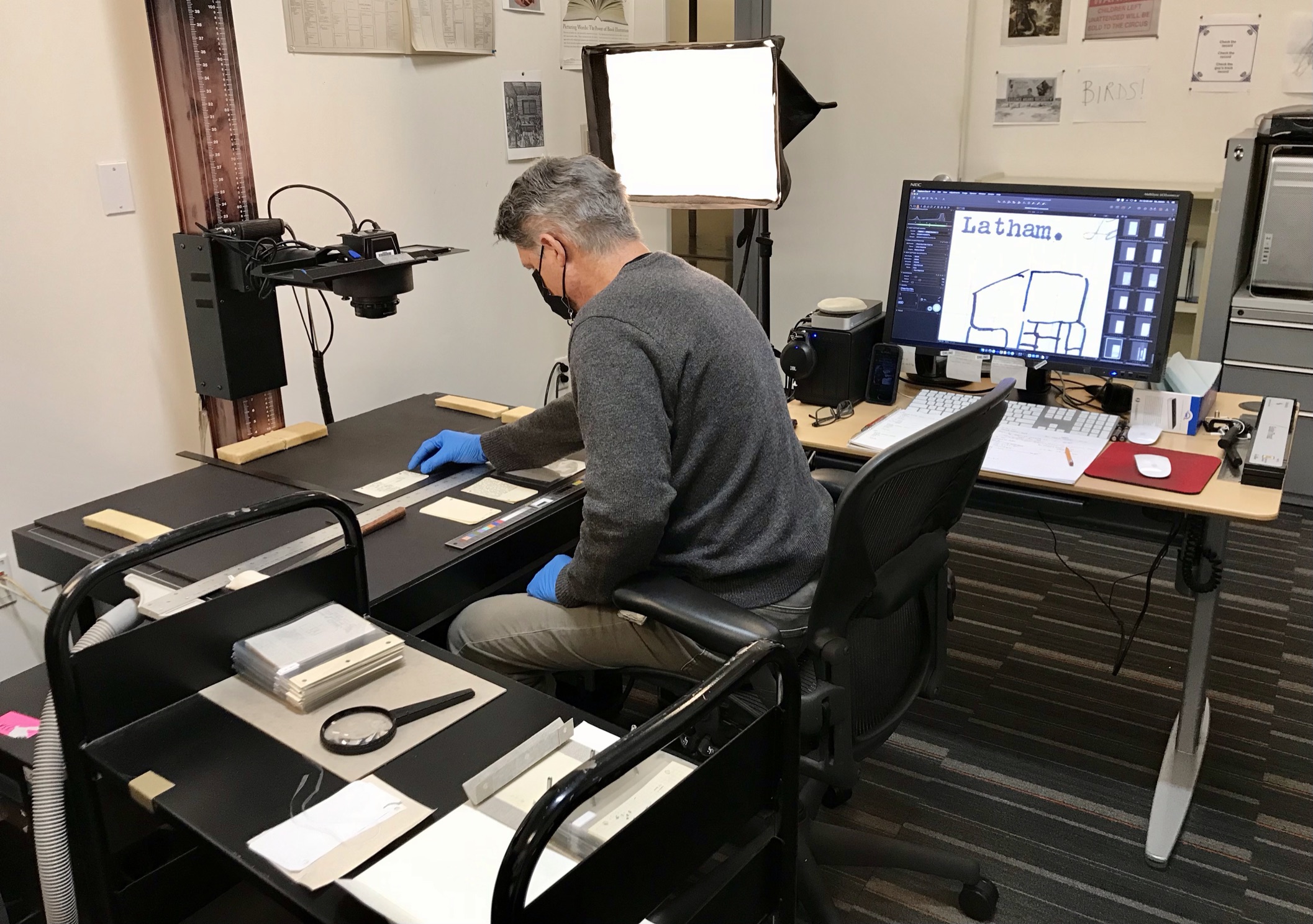This post was written by Katie Wagner, Senior Book Conservator, David Holbert, Digital Imaging Specialist, and Jacqueline E. Chapman, Head, Digital Library and Digitization. Learn more about the diaries of the Hewitt Sisters in a previous post by Jennifer Cohlman Bracchi.
In February 2020 the Smithsonian Libraries and Archives was awarded an American Women’s History Initiative grant to conserve and stabilize the 23 diaries kept by the Hewitt sisters during their travels. These diaries would eventually be featured in the Cooper Hewitt, Smithsonian Design Museum’s exhibition, Sarah and Eleanor Hewitt: Designing a Modern Museum.
To support their long-term preservation, research use, and future exhibition, the diaries would be stabilized and rehoused by a contractor focused exclusively on this detailed conservation work. Afterwards, the items would be digitized by our Digitization team to provide broad access and to prevent unnecessary handling of the fragile objects.

What started as an exciting and straightforward project for a contractor to work on-site alongside our Preservation team, became a more challenging operation when just a month later pandemic safety protocols came into place.
To complicate matters, prior to the pandemic, six of the 23 volumes had already been sent from their usual location at the Cooper Hewitt, Smithsonian Design Library in New York City, to our Book Conservation Lab (BCL) in Landover, MD in preparation for the exhibition. With the closure of our on-site facilities during the pandemic, retrieving and relocating the remaining volumes to the BCL was not immediately possible.
The decision was made to hire two contractors, one near the Landover location and one in New York, to conserve the diaries in their own studios, prioritizing the six diaries needed for the exhibition. The complex physical nature of these diaries demanded an innovative approach to rehousing them to maintain the integrity of the original format.

Most of the diaries were housed in commercial two-ring binders covered in leather that had degraded over time. Covers were detached, and in some cases, missing. The diaries included many scraps of ephemera from acidic newspaper clippings to calling cards, to sketches. The inclusion of these items caused some of the binders to become overfilled leading to detached pages.
Smithsonian Libraries and Archives conservators worked closely with the contractors to ensure that both the pages and the ephemeral pieces maintained their original order for research purposes, preserving both the physical pages and pieces as well as the intellectual content and associations between the ephemera and the diary pages.
Each page of each diary was placed in Mylar L-sleeves and bound in a post-binding. This allowed us to retain the original order and for researchers to readily access the volumes without having to touch the fragile pages directly. The ephemeral pieces were flattened and stored separately (as many were too large for binding once unfolded) and all the elements of the original binding were housed in an acid-free double tray box.

After treatment, the diaries were ready for their time under the cameras and care of our Digitization team at our Imaging Center (IC) located in the same building as our BCL. A new challenge arose: digitization could not begin until November 29th, and the diaries needed to be back at the Cooper Hewitt by December 17th. With special permission from our Emergency Operations Group, and with numerous safety protocols in place, Digital Imaging Specialist David Holbert returned to the IC to complete this phase of the project. With extensive treatment photos and notes from the contract conservator, we were able to prepare for the imaging process in advance.

Due to their rarity and fragility, the diaries were digitized on ‘copy stand’ equipment, with a camera attached to a motorized column that can be raised and lowered. The majority of the pages were approximately the same size (6” x 4”). This allowed for an efficient workflow, with limited adjustments to the camera position. Once the correct height on the column was set for a captured image to meet resolution requirements, and in proper focus, the camera could remain at the same location for imaging each diary page.
Capturing the front and back of each page, while monitoring for focus, went quickly. But, because the pages were unnumbered, extra care needed to be taken to ensure that the original order was maintained during this work. The careful removal and re-insertion of each fragile page out of and into their protective Mylar L-sleeves proved to be the most time-consuming part of the process.

The oversized ephemera, pre-flattened and also housed in Mylar sleeves, were set aside and imaged separately after completing the more standardized diary pages. More camera adjustments were needed for this work, with ephemeral pieces of varying size.
The image capture process took roughly 80 hours and was completed in time for the diaries to make their return trip to New York for final exhibition preparations and installation. However, the images still required post-production work before they could be uploaded for online viewing. The images needed to be cropped, the RAW files processed into TIFFs, and page-level metadata applied to each image.
Importantly, because the original placement of these ephemeral pieces within each diary had been recorded in the conservation process, the digital surrogates of the diaries are able to reflect the original order and appearance of the diaries rather than their current housing. The digital images of each piece of ephemera were able to be inserted where the physical ephemeral pieces were originally found in each diary.
Post-production work and uploading the diaries’ digital surrogates to the Internet Archive and our Digital Library took another approximately 40 hours. All six diaries were available online by December 21st, and can be viewed in our Digital Library. In total, the diaries amounted to 1,816 images.

With these first six diaries now complete, we now turn to the remaining 17 which will go through a similar workflow for conservation and digitization. In the meantime, we are able to celebrate the opening of the Cooper Hewitt Museum’s exhibition where pages from the diaries are now safely on display.

Additionally, we have uploaded three of the diaries from this first batch of six to the Smithsonian Transcription Center where volunpeers (volunteer transcribers) will lend their skills and time to augmenting these images by providing searchable text, rendering them even more accessible. We look forward to sharing more diaries as the project continues, and hearing from readers, researchers, and volunpeers about their own travels through the sisters’ diaries, as we together unlock their contents and illuminate Sarah and Eleanor’s lives in their own words.


Be First to Comment